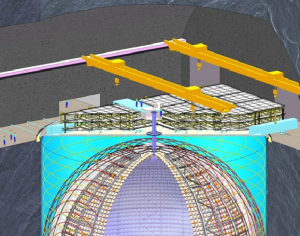JUNO is an experiment dedicated to the measurement of the neutrino mass hierarchy, one of the main issues still open in particle physics.
It is located in the Popular Republic of China, near Jiangmen town, 50 km away from two nuclear power plants, providing 26.6 GW starting from 2020.The detector is made by an acrylic sphere, of 35 m diameter, containing 20000 tons of liquid scintillator. The sphere is submerged in a water tank, used as a Water Cerenkov VETO for cosmic rays.
In the apparatus, 20000 20-inch photomultipliers and 25000 3-inch photomultipliers are installed.
Above the water pool, it is located a cosmic ray tracker (Top Tracker) made by scintillator strips; cosmogenic events are indeed the main background source for reactor anti-neutrino events.
JUNO will be able also to perform precise measurements of mixing parameters, in addition to being an observatory of neutrinos produced by natural sources, such as the Sun, the Earth, supernovae and cosmic rays.
The detector installation will start during 2021.
The LNF team is involved mainly in the realization of the read-out electronics of the Top Tracker, but also in the design of the experiment computing model. Furthermore, in cooperation with Roma Tre University, it contributes to the realization of the read-out electronics of Tao – the JUNO reference detector – needed for the precise measurement of electron anti-neutrino spectrum at short distance from the reactors.
 INFN-LNF Laboratori Nazionali di Frascati
INFN-LNF Laboratori Nazionali di Frascati
